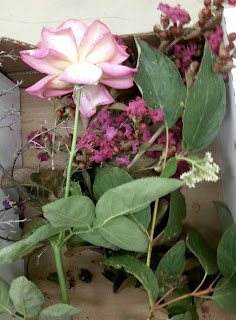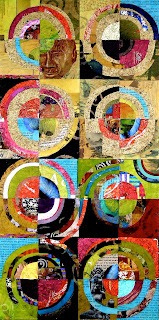 |
| Object would Not Stand Still, detail, HKH ©2010 |
I also included photographs of pieces I love, but were not included in the review.
By Melissa Hiatt
Enterprise art critic
August 19, 2010
The little things can really get under your skin: the gummed-up, crusted-over toothpaste that slowly oozed out of its hole in a desperate attempt to reach for its lid; the milk left out on the counter, which clearly establishes a horridly sour smell ... and the simple fact that another trip to the market will be necessary, in order to facilitate morning coffee and continued existence.
 |
| Underwater Drama, Marcia Cary ©2007 |
I think they might be wrong.
Just who are 'they' anyway ... and what do they want?
Who would knowingly prescribe 'failure to pay attention' as a life philosophy? After all, a great deal of spiritual counseling advises noticing all things.
Entire practices can be devoted to the art of present observation.
 |
| Shell, Sara Post ©2010 |
Innocence, which says it all:
To see the world in a grain of sand,
And heaven in a wild flower,
Hold infinity in the palm of your hand,
And eternity in an hour.
Everyday, ordinary things cannot only be transformative; they are, by their very nature, formative. The things we use daily offer cadence to our movements, rhythm to our methods.
Imagine flipping pancakes without a spatula.
 |
| Code, Tomas Post ©2010 |
Little things can become so much a part of our lives that we fail to notice their significance: whether they serve to annoy, dole out convenience, or provide the placebo of peace of mind.
Artist and curator Sara Post is determined that we stand up and take note. This month's Davis Art Center Tsao Gallery exhibit is filled with art centered on everyday things. Post's concept refers to a lost curriculum practice from French primary school, regarding the study of objects: their history, their evolution and their uses.
 |
| Dark Freesia 1, StaceyVetter ©2010 |
According to Post, 'this exhibit offers an opportunity to slow down, to focus, to be with and perhaps to add to our understanding and enjoyment of objects that surround us.'
The participating artists are Chris Beer, Marcia Cary, Magdelena Crivelli, Barbara DeWein, Julie Haney, Hannah Hunter, Diana Jahns, Jose Moreno, Sondra Olson, Sara Post, Tom Post, Laura Reyes, Adele Shaw, Alison Smith, Stacey Vetter and Stacey White.
Sara Post is a nationally exhibited artist, and she shares a studio with her husband and fellow artist, Tom. While she has one piece in the show, 'Les Animaux d'Ivoire,' which bears her brush and hot wax signature of encaustic, she also shows three companion pieces that are a clear departure.
 |
| Jar, Sara Post ©2010 |
'Jar,' 'Umbrella' and 'Shell' depict these singular objects within a surreal environment and rest them ethereally, without the force of gravity. Their suspension creates both tension and intrigue. By removing the object from a traditional setting, the viewer is forced to consider
it solely on its own.
Jose Moreno's 'Bell' rings from his found object series. Moreno sees 'the object as a tool for expanding one's understanding of surface and light.' His tremendous skill shines through. Moreno's definitive realism
is imbued with a rich, warm light and tender sense of antiquity.
 |
| Coffee Container, Jose Moreno ©2010 |
The list of things to love is long. Christopher Beer's pill-popping pieces are both witty and intriguing. Hannah Klaus Hunter's collages
consistently radiate a vitality and evolution that are intensely emotional. Julie Haney's 'Pie Spatulas' are a surprising favorite. Her choice of monotype led to an extraordinary representation, wherein the
purpose of the object fades completely when faced with its design.
The message is clear: It's time to consider the things we so often dismiss.
Lessons from Things, on view at the Tsao Gallery in the Davis Art Center through September 3rd.




















